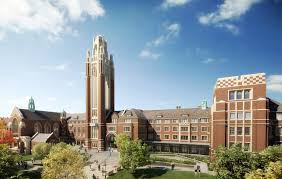The University of Chicago came to life in the twilight of the 19th century, with the state of Illinois issuing its official certificate of incorporation in September 1890. A $600,000 pledge from oil magnate John D. Rockefeller helped to get the university off the ground, while local department store owner Marshall Field donated land. The vision of the university’s first president was of a “bran splinter new” institution “as solid as the ancient hills” – a modern research university with a commitment to equal opportunities and non-sectarianism.
This vision has been at the core of Chicago’s existence, enshrined in its motto: Crescat scientia; vita excolatur (“Let knowledge grow from more to more; and so be human life enriched”). The university has lived up to this by being at the forefront of major academic endeavour and discovery. It has connections to more than 80 Nobel laureates, 30 National Medal winners (across humanities, arts and science) and nine Fields Medallists. It has also been awarded nearly 50 MacArthur “genius grants”.
Current faculty who have won a Nobel prize while at Chicago include economists Robert E. Lucas (1995), James J. Heckman (2000), Roger Myerson (2007), Lars Peter Hansen (2013), Eugene Fama (2013), and physicist James Cronin (1980). Ngô Bao Châu, the first Vietnamese to win the Fields Medal (2010), is the Francis and Rose Yuen distinguished service professor in Chicago’s department of mathematics.
Notable alumni of Chicago include authors Saul Bellow and Susan Sontag, astronomer Edwin Hubble, film critic Roger Ebert, and everyone’s favourite celluloid academic and archaeologist, Indiana Jones – who also taught at the university.
While Chicago routinely ranks in the world’s top institutions academically, its prowess extends to the sporting arena. It was a founding member of the Big Ten Conference, the oldest, highest-level intercollegiate athletics conference in the US. Today the university sponsors 19 intercollegiate sports, which cater for more than 500 participants and 330 competitions taking place each year. They all play under the same name, “the Maroons”, which the university was nicknamed on account of its official colour.
The university’s campus sprawls over more than 210 acres in the Hyde Park and Woodlawn neighbourhoods, which lie south of downtown Chicago. Its first buildings were modelled on the Gothic style of the University of Oxford, but by the mid-20th century, modern buildings had begun popping up to intersperse old and new. It now blends a mix of classical and contemporary architecture from the Mitchell Tower and Robie House, architect Frank Lloyd Wright’s historic residence, through to the Laird Bell Law Quadrangle.
The city of Chicago itself is the university’s “laboratory, playground, and muse”, with downtown highlights encompassing restaurants, shopping and cultural attractions. In one day you could visit the Navy Pier amusement park, the Art Institute of Chicago or shop on the Magnificent Mile.
With satellite campuses and facilities overseas, UChicago has transcended its US geography to make itself an international institution. It invites prospective students to step inside its walls and “walk along the paths of Nobel laureates, pathbreaking researchers, and tomorrow’s leaders”.


No comments:
Post a Comment